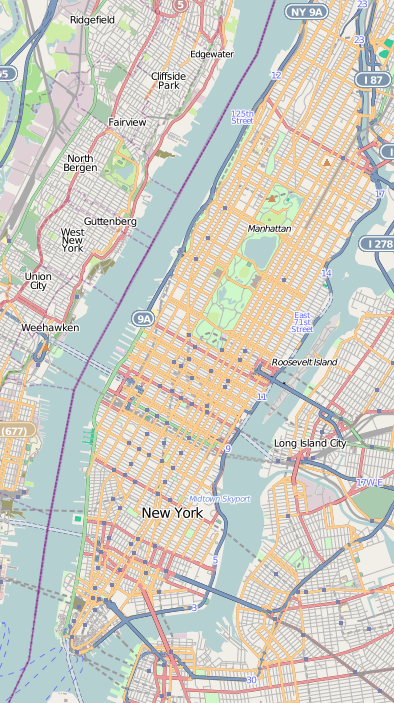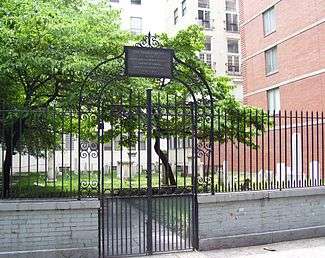Congregation Shearith Israel
The Congregation Shearith Israel (Hebrew: קהילת שארית ישראל Kehilat She'arit Yisra'el "Congregation Remnant of Israel") – often called The Spanish and Portuguese Synagogue – is the oldest Jewish congregation in the United States. It was established in 1654 in New Amsterdam by Jews who arrived from Dutch Brazil.[1] Until 1825, when Jewish immigrants from Germany established a congregation, it was the only Jewish congregation in New York City.
| Congregation Shearith Israel | |
|---|---|
Congregation Shearith Israel at Central Park West | |
| Religion | |
| Affiliation | Orthodox Judaism |
| Rite | Sephardi |
| Status | Active |
| Location | |
| Location | 2 West 70th Street |
| Municipality | New York City |
| State | New York |
| Country | United States |
 Location within Manhattan | |
| Geographic coordinates | 40°46′29.5″N 73°58′38.3″W |
| Architecture | |
| Architect(s) | Arnold Brunner |
| Style | Neoclassical |
| Date established | 1654 |
| Completed | 1897 |
| Direction of façade | East |
| Website | |
| www | |

The Orthodox synagogue, which follows the Sephardic liturgy, is located on Central Park West at 70th Street, on the Upper West Side of Manhattan. The congregation has occupied its current Neoclassical building since 1897.[2]
Founding and synagogue buildings

_5_WEST_19TH_STREET.jpg)
The first group of Spanish and Portuguese Jews were twenty-three refugees from Dutch Brazil, who arrived in New Amsterdam in September 1654. After being initially rebuffed by anti-Semitic Director of New Netherland Peter Stuyvesant, Jews were given official permission to settle in the colony in 1655. This year marks the founding of the Congregation Shearith Israel. Although they were allowed to stay in New Amsterdam, they faced discrimination and were not given permission to worship in a public synagogue for some time (throughout the Dutch period and into the British). The Congregation did, however, make arrangements for a cemetery beginning in 1656.
It was not until 1730 that the Congregation was able to build a synagogue of its own; it was built on Mill Street (now William Street) in lower Manhattan. The Mill Street synagogue was said to have had access to a nearby spring which it used as a mikveh for ritual baths.[3] Before 1730, as noted on a 1695 map of New York, the congregation worshipped in rented quarters on Beaver Street and subsequently on Mill Street. Since 1730 the Congregation has worshipped in five synagogue buildings:
- Mill Street, 1730
- Mill Street re-built and expanded, 1818
- 60 Crosby Street, 1834
- 19th Street, 1860
- West 70th Street, 1897 (present building)
The current building was extensively refurbished in 1921.[4]
Founding major Jewish institutions
As the American Reform Judaism made headway in the late 19th century, many rabbis critical of the Reform movement looked for ways to strengthen traditional synagogues. Shearith Israel, and its rabbi, Henry Pereira Mendes, were at the fore of these efforts. Rabbi Mendes cofounded the American Jewish Theological Seminary (JTS) in 1886, in order to train traditional rabbis. The school held its first classes at Shearith Israel. In JTS' earliest days, it taught and researched rabbinics similarly as was done in traditional yeshivas, in contrast to the Reform Hebrew Union College.
Twelve years later, in 1896, Mendes was acting president of JTS. He promoted the formation[5] of the Union of Orthodox Jewish Congregations of America (commonly known as the OU, the Orthodox Union). This synagogue umbrella group provided an alternative to the Reform movement's Union of American Hebrew Congregations.
As JTS grew, it needed better financing and a full-time head. The seminary moved to its own building, and Mendes was replaced by Solomon Schechter. However, Schechter developed a less traditional approach, which became the basis for Conservative Judaism (called Masorti outside North America). Initially there was considerable cooperation between the Orthodox and Conservative groups but, over time, the divide became clearer.
Schechter formed the United Synagogue of America (now the United Synagogue of Conservative Judaism, or USCJ)to promote synagogue affiliation with his conservative ideology.[6]
Shearith Israel remained aligned with the Orthodox tradition. It eventually repudiated its association with JTS. In a sense, Shearith Israel helped create three of the largest and most significant Jewish religious organizations in the United States: JTS, the OU, and USCJ. Shearith Israel remains a member only of the Orthodox Union.
_by_David_Shankbone_crop.jpg)
Clergy
Rabbis
- Benjamin Wolf[7]
- Gershom Mendes Seixas (not ordained): Hazzan of the Congregation and an ardent American patriot; he moved the Congregation to Philadelphia after the British occupied the city during the American Revolutionary War.
- Moses L. M. Peixotto[8] (not ordained)
- Isaac B. Seixas (1828-1839)[8]
- Jacques Judah Lyons (1839-1877)
- Henry Pereira Mendes (1877-1920)
- David de Sola Pool - two stints (1907-1919 and 1921-1955). He was hired as assistant rabbi in 1907, and left in 1919. A year later, Mendes retired, and the synagogue went through a succession of candidates until de Sola Pool agreed to return in 1921. Herbert Goldstein was announced as rabbi, but did not actually take the pulpit. Reverend Joseph Corcos was appointed interim rabbi.[9][10]
- Louis B. Gerstein (1956-1988)
- Marc D. Angel (1969-2007)
- Hayyim Angel (1995-2013)
- Meir Y. Soloveichik (2013-)
Parnasim (Presidents)
- Luis Moises Gomez
- Moses Raphael Levi (1665–1728)
Hazanim[11]
- Saul Moreno d. 1682[7]
- Saul Pardo (1657–1702)
- Abraham Haim de Lucena (1703?–1725)
- Moses Lopez de Fonseca (??–1736)
- David Mendes Machado (1736–1746)
- Benjamin Pereira (1748–1757)
- Isaac Cohen da Silva (1757–1758 and 1766–1768)
- Joseph Jessurun Pinto (1758–1766)
- Gershom Mendes Seixas (1768–1776 and 1784–1816)
- Isaac Touro (1780)
- Jacob Raphael Cohen (1782–1784)
- Eleazar S. Lazarus (1816-1820)
- Moses Levy Maduro Peixotto(1816–1828)
- Isaac Benjamin Seixas (1828–1839)
- Jacques Judah Lyons (1839–1877)
- David Haim Nieto (1878–1886)
- Abraham Haim Nieto (1886–1901)
- Isaac A. H. de la Penha (1902–1907)
- Isaac A. Hadad (1911–1913)
- Joseph M. Corcos (1919–1922)
- James Mesod Wahnon (1921–1941)
- Abraham Lopes Cardozo (1946–1986)[12]
- Albert Gabbai (1983-1986) [13]
- Phil Sherman
- Ira Rohde
Prominent members
- Albert Cardozo – Justice of the New York Supreme Court
- Benjamin N. Cardozo – Justice of the Supreme Court of the United States, 1932–1937
- Judith Kaye – Chief Judge of New York, 1993–2008
- Emma Lazarus – poet
- Commodore Uriah P. Levy – the first Jewish Commodore of the United States Navy
- Edgar J. Nathan – Manhattan Borough President and justice of the New York Supreme Court
- Mordecai Manuel Noah – American sheriff, playwright, diplomat, and journalist
- Isaac Pinto – prepared the first Jewish prayer book published in America, which was also the first English translation of the Siddur
- Jack Rudin – real estate developer
- Arthur Tracy – singer and actor
See also
- First Shearith Israel Graveyard
- Jewish history in Colonial America
- Touro Synagogue (Newport, Rhode Island), the oldest synagogue building in the U.S., was long thought to be owned by Congregation Shearith Israel. The claim was rejected by a federal district court in a 2016 legal suit.[14] The First Circuit Court of Appeals in Boston, in a decision written by retired Supreme Court Justice David Souter, overturned this ruling in 2017.[15] Jehudat Israel petitioned for certiorari in the U.S. Supreme Court. On March 2, 2019, the Supreme court denied certiorari, effectively allowing the decision in favor of Congregation Shearith Israel to stand.[16]
- Oldest synagogues in the United States
References
- Notes
- Marcus, Jacob R. "Early American Jewry: The Jews of New York, New England, and Canada, 1649–1794." Philadelphia: Jewish Publication Society, 1951. Vol. I, pp. 3, 20–23
- Congregation Shearith Israel Archived February 17, 2007, at the Wayback Machine, Building Report, International Survey of Jewish Monuments. Retrieved April 3, 2007.
- Dyer, Albion Morris (1895). "Points in the First Chapter of New York Jewish History". Publications of the American Jewish Historical Society. American Jewish Historical Society. pp. 54–55.
- "New York Happenings". The American Israelite. October 6, 1921. pp. P2. Retrieved August 13, 2020 – via Newspapers.com

- "The Orthodox Union Story, chs. 5–6". Ou.org. Archived from the original on August 21, 2011. Retrieved October 15, 2011.
- From the Beginning... Archived January 13, 2009, at the Wayback Machine
- Phillips, N. Taylor (1897). "The Congregation Shearith Israel An Historical Review". American Jewish Historical Quarterly. American Jewish Historical Society. pp. 126–129.
- "SEIXAS - JewishEncyclopedia.com". www.jewishencyclopedia.com. Retrieved August 14, 2020.
- "The Rev. Dr. Herbert S. Goldstein has been called the to Spanish and Portuguese Synagog..." The American Israelite. November 24, 1921. pp. P2. Retrieved August 14, 2020 – via Newspapers.com

- "New York Happenings". The American Israelite. October 6, 1921. pp. P2. Retrieved August 13, 2020 – via Newspapers.com

- "ITEMS RELATING TO CONGREGATION SHEARITH ISRAEL, NEW YORK". Publications of the American Jewish Historical Society (27): 262–278. 1920. ISSN 0146-5511.
- De Sola Pool, David and Tamar (1955). An Old Faith in the New World: Portrait of Shearith Israel, 1654–1954. New York, NY: Columbia University Press. pp. 158–186.
- https://shearithisrael.org/sites/default/files/2019/07/media/Out%20of%20Egypt%20Booklet%20-%20final.pdf
- Malone, Scott (May 16, 2016) "Rhode Island Congregation Wins $7M Shul vs. Shul Legal Battle Over Shearith Israel", The Forward
- "- The Washington Post". Washington Post. ISSN 0190-8286. Retrieved February 16, 2018.
- Congregation Jeshuat Israel v. Congregation Shearith Israel, No. 18-530 (S.Ct. March 2, 2019). Text
- Bibliography
- Brockmann, Jorg and Bill Harris. (2002). One Thousand New York Buildings. New York: Black Dog & Leventhal. ISBN 9781579122379; OCLC 48619292